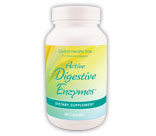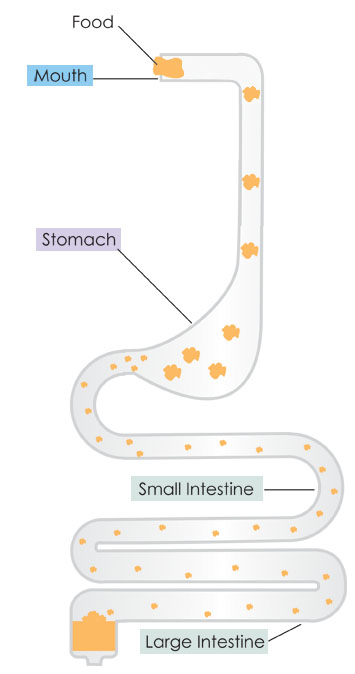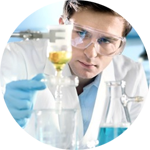Digestive Enzymes
Enzymes are catalysts, or substances that speed up the rate of reaction but are not changed or used up in the reaction. They are proteins and highly specific for the substrates, or molecules/nutrients, that they can cat on.
Enzyme Reaction Process
- 1. Enzyme and substrate are available
- 2. Substrate binds to enzyme
- 3. Substrate is converted and products are released
|
|
|
Step-by-Step Digestion
In the Mouth
- In the mouth food is chewed and mixed with saliva, softening it so that it can be swallowed easily
- Ptyalin is an enzyme released by the salivary glands, which acts on some starch, converting it to sugar. It is a type of alpha-amylase (salivary amylase)
In the Stomach
- In the stomach food is acted on by gastric juice
- Hydrochloric acid (HCl) breaks down proteins, preparing them for digestion
- HCl activates the enzyme, pepsin, which is secreted by gastric glands in an inactive form (called pepsinogen)
- Pepsin is the first enzyme to digest nearly every type of protein into smaller peptide fragments
- Other minor gastric enzymes (those enzymes secreted in the stomach):
- Geltinase breaks down type I and type V gelatin and type IV and type V collagen. In humans geltinases are called matrix metalloproteinases MMP2 and MMP9
- Gastric amylase degrades starch, but is not significant
- Gastric lipase digests fats, but not relevant in adults
- Chymosin (or Rennin) is an enzyme that changes liquid milk to a solid
- Produced by gastric chief cells in infants in order to curdle the milk they ingest, allowing for greater absorption of nutrients
- Food, gastric juice, and mucus combine to form chyme, which travels to the small intestine
In the Intestines
- Most digestion occurs in the small intestine
- In the duodenum chyme is mixed with bile delivered from the liver and gallbladder through the common bile duct
- Bile contains salts that emulsify (break-up) fats
- Pancreatic juice is also delivered to the small intestine from the pancreas. It contains sodium bicarbonate, which neutralizes the acidic chyme form the stomach, along with the enzymes:
- Lipase – digests almost all of the fat that the bile has emulsified
- Fats are broken down into glycerol and fatty acids, which are more absorbable
- If pancreatic lipase is absent, fats are expelled with the feces in an undigested form
- Amylase – converts starch to maltose (a simple sugar)
- Trypsin& Chymotrypsin – specific for certain amino acids, split proteins into small peptides
- Nucleases – digest nucleic acids DNA and RNA
- Note: when pancreatic juice is absent, serious digestive disturbances always occur
- Peptidases complete the digestion of peptides to amino acids
- The small intestine also produces the enzymes maltase, sucrase, and lactase which act on the disaccharides maltose, sucrose, and lactose respectively to convert them to simpler, more absorbable sugars
Related Products

|
Active Digestive Enzymes The foods we love to eat often rebel against us. We may be lactose intolerant - we can't digest dairy products. Or we get diarrhea, heartburn, acid indigestion or Irritable Bowel Syndrome. ADE's remarkable combination of 17 active ingredients may help you eat what you want - without the consequences. More Information
|
|
|
Summary
Organ |
Enzyme/Chemical Secreted |
Action |
Salivary glands |
Salivary amylase |
Begins starch digestion (polysaccharides to maltose) |
Stomach |
Hydrochloric acid (HCl)* |
Breaks down proteins |
Pepsin |
Begins protein digestion (proteins to peptides) |
Small Intestine |
Peptidases |
Digests peptides to amino acids |
Lactase, maltase, sucrase |
Digests disaccharides to monosaccharides or glucose (carbohydrate digestion) |
Pancreas |
Sodium bicarbonate* |
Neutralizes HCl |
Amylase |
Digests starch |
Trypsin |
Digests proteins to peptides |
Lipases |
Digests fats to fatty acids and glycerol |
Nucleases |
Digests nucleic acids |
Liver/Gallbladder |
Bile salts* |
Emulsifies fats |
*Not enzymes
|

 For over 14 years, we have made it our mission to collaborate with innovative practitioners, nutritional experts, and scientists to realize their concepts and ideas into life changing products and applications. This cultivated group called "The Founding Scientists," is what makes GHT the unique, robust and respected organization in industries of nutrition and health.
For over 14 years, we have made it our mission to collaborate with innovative practitioners, nutritional experts, and scientists to realize their concepts and ideas into life changing products and applications. This cultivated group called "The Founding Scientists," is what makes GHT the unique, robust and respected organization in industries of nutrition and health.
















